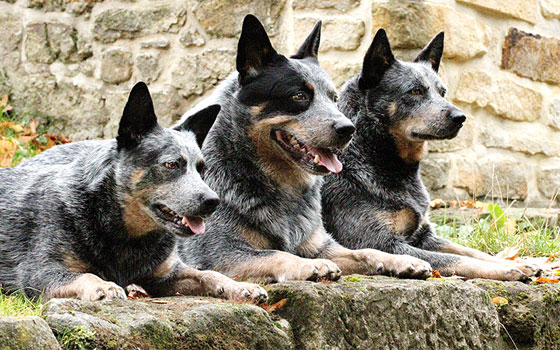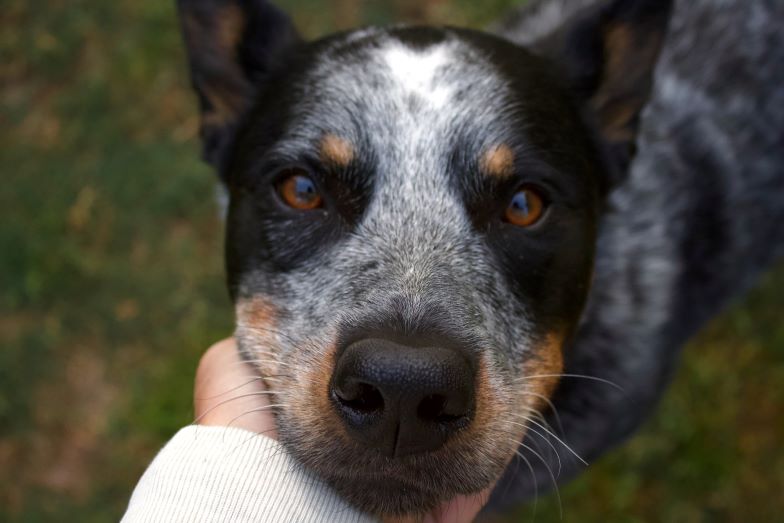Lifespan
12 to 16 years
By : Trupanion Staff | Updated Nov 15, 2024
Lifespan
12 to 16 years
Weight
35 - 50 pounds
17 - 20 inches tall
Energy level
Tri-athlete
Breed Group
Herding

Heelers have distinctive red or blue color coat patterns. Often confused for a merle pattern, Cattle Dogs have what’s called “speckled” or “mottled” coloring.
Australian Cattle Dogs have a short double coat. You’ll see ACDs in two varieties: Blue or Red. The Blue Heeler coat is a mixture of black and white fur. The more black fur interspersed in the white, the “darker” the blue. Their coat patterns can be classified as either “mottled” or “speckled,” depending on whether they have large patterns of white dots throughout their coat or have more of a blended salt-and-pepper pattern.
Even though the ACD has a double coat, it doesn’t require lots of work to keep in tip-top shape. The natural oil in the coat helps to slough off dirt and bad odors. Brush your Cattle Dog once a week to spread these oils throughout the coat and keep the skin healthy. Brushing might need to be done more frequently during seasonal shedding in spring and fall.
Bathing should be done as needed, but you don’t want to overwash the coat and strip its natural oils. Introduce your Cattle Dog puppy to the grooming experience from a young age to create a positive association and encourage calm behavior during bathing and brushing.
Best Brush for an Australian Cattle Dog: Undercoat rake, Pin brush
Outdoorsy. Rugged. Loyal. Full of vigor. The Australian Cattle Dog is not for the faint of heart! Their
The Australian Cattle Dog is the result of the intentional crossing of different dog breeds to create the perfect cattle dog for the rugged Australian terrain. Cattle drovers desperately needed to move herds of livestock from their grazing lands to the market, hundreds of miles away. The herding dogs imported from England were not suited to the climate or the long journeys.
In the late 1820s, Thomas Hall of New South Wales crossed tamed Dingoes with smooth-coated merle collies. After a couple of decades refining his drover dogs, he had created the predecessor to the Australian Cattle Dog, known as Hall’s Heelers. These dogs were kept in the family until his death in 1870, contributing to their success in the cattle industry.
Once Hall’s Heelers were freely available to other ranchers, they also became popular with dog fanciers that wanted to focus on showing rather than working. This shift in the 1880s led to an official breed standard in 1903. Interestingly, this time in the Australian Cattle Dog’s history is debated. Many historians of the breed believe the Bagust family, prominent breeders of the time, crossed them with the Dalmatian and the Kelpie to create what we know as the modern Cattle Dog. Others argue this wasn’t possible based on the timeline. Some theories don’t include the Hall’s Heelers at all, instead claiming that George Elliot was the originator of the Dingo-collie crosses that would become the Cattle Dog. Whatever their lineage, Australian Cattle Dogs proved to be indispensable working dogs throughout Australia.
It was during World War II that Americans became familiar with the Australian Cattle Dog. Soldiers stationed in Queensland during the war fell in love with the breed and brought them home. While recognized as a member of the miscellaneous breed group since the 1930s, it wasn’t until 1980 that the American Kennel Club officially recognized the Australian Cattle Dog. They were ranked as the 55th most popular dog breed in the United States in 2018.
The Cattle Dog will love to work with you and enjoys a challenge. This industriousness means the breed might not be the best for first-time dog owners, as their physical and mental needs require quite the commitment. An Australian Cattle Dog has naturally high “drives,” or behavioral propensity and desire toward things like herding, barking, chasing prey, and other work. It’s what they were bred to do!
This breed should always have a job that fulfills these high drives. Otherwise, an energetic Heeler can become hyperactive, anxious, and exhibit problem behaviors. Cattle Dogs need lots of positive reinforcement training, physical exercise, and mental stimulation to support a well-balanced life. The Cattle Dog will thrive in activities such as agility, herding, or Treibball (Urban Herding), and other dog sports where they can put their instincts to work.
Australian Cattle Dogs tend to be more reserved with people outside of their family and can be protective. Proper proactive exposure to new sights, sounds, people, dogs, and other animals as a young puppy is essential for their socialization skills.
Heelers are born to herd and drive cattle through nipping and barking. Cattle Dogs do best with older children in the home that don’t inadvertently encourage these herding behaviors with running and high pitched noises. Socialization as a puppy to younger children will help an Australian Cattle Dog learn how to interact with children appropriately but will not change their herding instincts. Young children and dogs should always be supervised, and it’s helpful for a dog to have their own “safe space” where they can go when they need some quiet time.

This breed can do well with other animals in the home if they are socialized as a puppy and properly introduced. However, Australian Cattle Dogs are known for being more attached to their people than to other pets in the home. Their herding instincts can make it hard for them to not chase after cats or other pets.
Daily exercise is so important for this herding breed, and they do best with at least an hour of physical activity every day. Australian Cattle Dogs love adventure and getting out with their people. Their athleticism, agility, and endurance level make them excellent jogging or hiking partners, once they’re fully grown.
Speak with your veterinarian about appropriate exercise for a Cattle Dog puppy. Until they’re full-grown (bone growth plates typically all close around 12 to 18 months of age), avoid jogging or running beyond what they would do on their own. This limits the risk of damage to the growing bone and cartilage, which can cause pain and future joint issues.
Bolster your Cattle Dog’s physical exercise with mental exercise as well — this is a very intelligent breed that needs problems to solve. Focus their brains on training exercises and teaching new tricks. Provide puzzles and interactive toys, and give them lots of environmental enrichment to keep them positively engaged with their surroundings. Enrichment and brain games are especially beneficial for puppies and will help prevent unwanted behaviors, such as chewing and boredom barking.
Australian Cattle Dogs do well in many different activities: